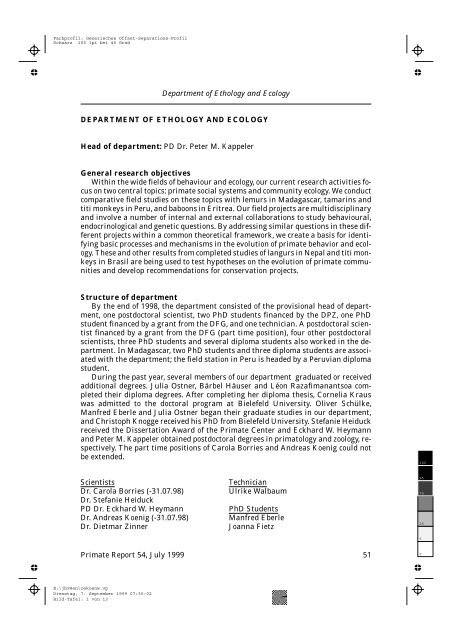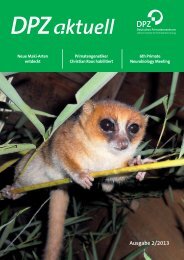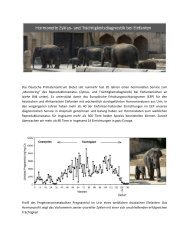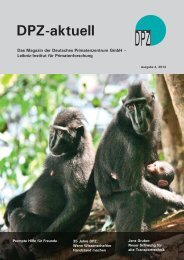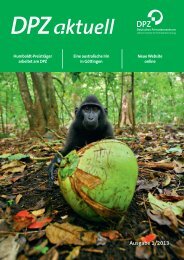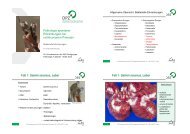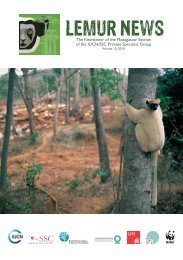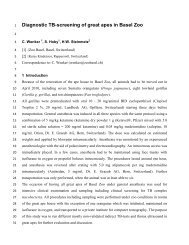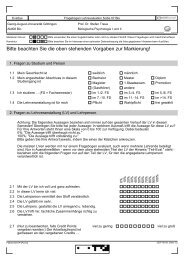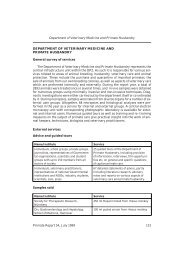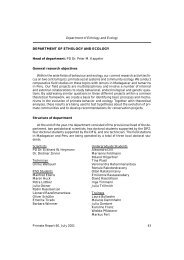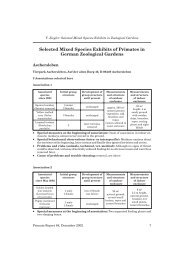DEPARTMENT OF ETHOLOGY AND ECOLOGY Head of ... - DPZ
DEPARTMENT OF ETHOLOGY AND ECOLOGY Head of ... - DPZ
DEPARTMENT OF ETHOLOGY AND ECOLOGY Head of ... - DPZ
Create successful ePaper yourself
Turn your PDF publications into a flip-book with our unique Google optimized e-Paper software.
Farbpr<strong>of</strong>il: Generisches Offset-Separations-Pr<strong>of</strong>il<br />
Schwarz 150 lpi bei 45 Grad<br />
Department <strong>of</strong> Ethology and Ecology<br />
<strong>DEPARTMENT</strong> <strong>OF</strong> <strong>ETHOLOGY</strong> <strong>AND</strong> <strong>ECOLOGY</strong><br />
<strong>Head</strong> <strong>of</strong> department: PD Dr. Peter M. Kappeler<br />
General research objectives<br />
Within the wide fields <strong>of</strong> behaviour and ecology, our current research activities focus<br />
on two central topics: primate social systems and community ecology. We conduct<br />
comparative field studies on these topics with lemurs in Madagascar, tamarins and<br />
titi monkeys in Peru, and baboons in Eritrea. Our field projects are multidisciplinary<br />
and involve a number <strong>of</strong> internal and external collaborations to study behavioural,<br />
endocrinological and genetic questions. By addressing similar questions in these different<br />
projects within a common theoretical framework, we create a basis for identifying<br />
basic processes and mechanisms in the evolution <strong>of</strong> primate behavior and ecology.<br />
These and other results from completed studies <strong>of</strong> langurs in Nepal and titi monkeys<br />
in Brasil are being used to test hypotheses on the evolution <strong>of</strong> primate communities<br />
and develop recommendations for conservation projects.<br />
Structure <strong>of</strong> department<br />
By the end <strong>of</strong> 1998, the department consisted <strong>of</strong> the provisional head <strong>of</strong> department,<br />
one postdoctoral scientist, two PhD students financed by the <strong>DPZ</strong>, one PhD<br />
student financed by a grant from the DFG, and one technician. A postdoctoral scientist<br />
financed by a grant from the DFG (part time position), four other postdoctoral<br />
scientists, three PhD students and several diploma students also worked in the department.<br />
In Madagascar, two PhD students and three diploma students are associated<br />
with the department; the field station in Peru is headed by a Peruvian diploma<br />
student.<br />
During the past year, several members <strong>of</strong> our department graduated or received<br />
additional degrees. Julia Ostner, Bärbel Häuser and Léon Razafimanantsoa completed<br />
their diploma degrees. After completing her diploma thesis, Cornelia Kraus<br />
was admitted to the doctoral program at Bielefeld University. Oliver Schülke,<br />
Manfred Eberle and Julia Ostner began their graduate studies in our department,<br />
and Christoph Knogge received his PhD from Bielefeld University. Stefanie Heiduck<br />
received the Dissertation Award <strong>of</strong> the Primate Center and Eckhard W. Heymann<br />
and Peter M. Kappeler obtained postdoctoral degrees in primatology and zoology, respectively.<br />
The part time positions <strong>of</strong> Carola Borries and Andreas Koenig could not<br />
be extended.<br />
Scientists<br />
Dr. Carola Borries (-31.07.98)<br />
Dr. Stefanie Heiduck<br />
PD Dr. Eckhard W. Heymann<br />
Dr. Andreas Koenig (-31.07.98)<br />
Dr. Dietmar Zinner<br />
Technician<br />
Ulrike Walbaum<br />
PhD Students<br />
Manfred Eberle<br />
Joanna Fietz<br />
Primate Report 54, July 1999 51<br />
E:\jb98en\oekoenw.vp<br />
Dienstag, 7. September 1999 07:30:02<br />
Bild-Tafel: 1 von 13<br />
100<br />
95<br />
75<br />
25<br />
5<br />
0
Farbpr<strong>of</strong>il: Generisches Offset-Separations-Pr<strong>of</strong>il<br />
Schwarz 150 lpi bei 45 Grad<br />
PhD Students<br />
Christoph Knogge<br />
Julia Ostner<br />
Rodin Rasoloarison<br />
Lèonard Razafimanantsoa<br />
Oliver Schülke<br />
Dorothea Schwab<br />
Barbara Wimmer<br />
Undergraduate Students<br />
Alexandra Dill<br />
Nikolaus von Engelhardt<br />
Andreas Hapke<br />
Bärbel Häuser<br />
Department <strong>of</strong> Ethology and Ecology<br />
Sonja Köhler<br />
Aina Rasamoelina<br />
Inga Timmann<br />
Emerita Tirado<br />
Trainees<br />
Katrin Böger<br />
Kathrin Dausmann<br />
Frederike Fellenberg<br />
Lisa Hoch<br />
Julia Küstner<br />
Pia Weidlich<br />
Andrea Weidt<br />
Nutrition and Seasonal Reproduction in Hanuman Langurs: Seasonal variation <strong>of</strong><br />
energy intake and energy expenditure leads to strong variation in the physical condition<br />
<strong>of</strong> females (–•–). An above-average physical condition is reached first in July and<br />
coincides with the period <strong>of</strong> conceptions (bar diagram; values indicate the number <strong>of</strong><br />
conceptions observed). The underlying hormonal changes are currently being investigated<br />
by the working group “Comparative Endocrinology”.<br />
52 Primate Report 54, July 1999<br />
E:\jb98en\oekoenw.vp<br />
Dienstag, 7. September 1999 07:30:06<br />
Bild-Tafel: 2 von 13<br />
100<br />
95<br />
75<br />
25<br />
5<br />
0
Farbpr<strong>of</strong>il: Generisches Offset-Separations-Pr<strong>of</strong>il<br />
Schwarz 150 lpi bei 45 Grad<br />
Progress during period under report<br />
Results<br />
In the past year, we made important progress on a number <strong>of</strong> fronts. In Madagascar,<br />
Oliver Schülke succeeded in capturing and radiocollaring fork-marked lemurs,<br />
so that it is now possible to initiate a field study <strong>of</strong> this intriguing lemur. Julia<br />
Ostner developed the necessary methodology for her study <strong>of</strong> the socio-endocrinology<br />
<strong>of</strong> redfronted lemurs. Barbara Wimmer developed the genetic tools necessary for the<br />
analyses <strong>of</strong> kin relations in several lemur species. Preliminary results <strong>of</strong> Rodin<br />
Rasoloarison's thesis work indicate the existence <strong>of</strong> at least four species <strong>of</strong> mouse lemurs<br />
that are new to science.<br />
Scent marking events / hour<br />
0,7<br />
0,6<br />
0,5<br />
0,4<br />
0,3<br />
0,2<br />
0,1<br />
0,0<br />
p < 0.01<br />
Department <strong>of</strong> Ethology and Ecology<br />
Male Female<br />
Different aspects <strong>of</strong> olfactory communication were addressed in coordinated comparative<br />
studies in tamarins and lemurs. Moustached tamarins (left graph) show a pronounced<br />
sexual dimorphism in favour <strong>of</strong> females with regard to scent marking (from:<br />
Heymann, E.W. (1998): Behav. Ecol. Sociobiol. 43:40). Latency <strong>of</strong> reaction <strong>of</strong> male<br />
and female recipients to three different types <strong>of</strong> scent marks in Lemur catta (right<br />
hand graph). Mean latencies (+SE) between deposition <strong>of</strong> female anogenital (Female<br />
AG), male anogenital (Male AG) and male antebrachial (Male AB) scent marks and<br />
first reaction with the same signal in male (black bars) and female (hatched bars) recipients<br />
are shown. The type <strong>of</strong> scent mark, but not sex <strong>of</strong> recipient, significantly influences<br />
mean latency. In a two-way ANOVA, the interaction (type x sex <strong>of</strong> recipient) was<br />
not significant (from: Kappeler, P.M. (1998): Behav. Ecol. Sociobiol. 42:411).<br />
Considerable progress was also made in the research carried out in Peru. Emerita<br />
Tirado succeeded in habituating red titi monkeys, Callicebus cupreus, so that a new<br />
comparative study <strong>of</strong> their behavioral ecology can now be initiated. The comparisons<br />
with the completed studies by Stefanie Heiduck on Brazilian masked titi monkeys,<br />
Callicebus personatus, and the ongoing studies on moustached and saddle-back<br />
tamarins (Saguinus mystax, Saguinus fuscicollis) provide an opportunity to elucidate<br />
the relative importance <strong>of</strong> ecological and phylogenetic factors in the evolution <strong>of</strong><br />
specific socio-ecological adaptations. Christoph Knogge and Emerita Tirado finished<br />
Primate Report 54, July 1999 53<br />
E:\jb98en\oekoenw.vp<br />
Dienstag, 7. September 1999 07:30:10<br />
Bild-Tafel: 3 von 13<br />
100<br />
95<br />
75<br />
25<br />
5<br />
0
Farbpr<strong>of</strong>il: Generisches Offset-Separations-Pr<strong>of</strong>il<br />
Schwarz 150 lpi bei 45 Grad<br />
Department <strong>of</strong> Ethology and Ecology<br />
their theses. Their results detailed the role <strong>of</strong> tamarins in seed dispersal and, thus,<br />
forest regeneration, and provide a basis for further specific studies <strong>of</strong> this aspect <strong>of</strong><br />
ecology.<br />
In Eritrea, Dietmar Zinner completed a nationwide survey <strong>of</strong> hamadryas baboons<br />
and grivet monkeys. This information will be useful for local conservation activities.<br />
In addition, the classification <strong>of</strong> eco-zones was also completed, so that their covariation<br />
with primate distribution and abundance can now be examined. During this<br />
phase <strong>of</strong> the study significant methodological progress has been made in terms <strong>of</strong> an<br />
integration <strong>of</strong> ecological, demographic and socio-economic information in a GIS. All<br />
this experience will be very useful in future conservation projects <strong>of</strong> the <strong>DPZ</strong> in<br />
other parts <strong>of</strong> the world.<br />
External collaborations<br />
Despite the ongoing uncertainty <strong>of</strong> planning for the department, new external<br />
cooperations were established and existing ones extended.<br />
• A collaboration contract with the Parc Botanique et Zoologique de Tsimbazaza <strong>of</strong><br />
Madagascar provides a framework for future collaborations. The first project will<br />
focus on the anatomy <strong>of</strong> the visual system <strong>of</strong> lemurs.<br />
• A collaboration with the Laboratoire d'Ecologie de MNHN à Paris (Dr. M. Perret)<br />
will allow the exchange <strong>of</strong> doctoral students to integrate our studies <strong>of</strong> reproduction<br />
and physiology in captivity and the field.<br />
• In a joint project with the MPI for Brain Research (PD Dr. L. Peichl), the anatomy<br />
<strong>of</strong> the visual system <strong>of</strong> lemurs with different activity patterns is being studied.<br />
• In collaboration with Pr<strong>of</strong>. Dr. H. Erkert (University Tübingen) we now use actometers<br />
to register the activity <strong>of</strong> cathemeral lemurs.<br />
• The existing cooperation with the Universidad Nacional Mayor de San Marcos in<br />
Lima (F. Encarnación and R. Aquino) on the Biogeography and Conservation <strong>of</strong><br />
Amazonian primates was intensified.<br />
• The cooperation between the Dept. <strong>of</strong> Landuse and Conservation <strong>of</strong> the University<br />
<strong>of</strong> Applied Science <strong>of</strong> Eberswalde and the University Autónoma de Madrid contributed<br />
strongly to the success <strong>of</strong> the hamadryas baboon project in Eritrea. Also<br />
the collaboration with the University <strong>of</strong> Asmara made considerable progress. During<br />
the next field campaign Eritrean students will participate for the first time in<br />
the hamadryas baboon project. Additionally, members <strong>of</strong> European primate research<br />
groups are becoming interested in a collaboration, e.g. from the University<br />
<strong>of</strong> Antwerp, Belgium.<br />
Field stations<br />
Work in Madagascar continued to make progress. The research station was<br />
partly remodeled and supplied with a new solar panel. Another 20 ha grid system<br />
was also established, further improving our working conditions. This increased our<br />
study area to more than 120 ha with about 80 km <strong>of</strong> trails. The station continued to<br />
be used by numerous external users and <strong>DPZ</strong> staff. Two field courses <strong>of</strong> the Universities<br />
in Antananarivo and Würzburg took place at our station and two film teams<br />
54 Primate Report 54, July 1999<br />
E:\jb98en\oekoenw.vp<br />
Dienstag, 7. September 1999 07:30:11<br />
Bild-Tafel: 4 von 13<br />
100<br />
95<br />
75<br />
25<br />
5<br />
0
Farbpr<strong>of</strong>il: Generisches Offset-Separations-Pr<strong>of</strong>il<br />
Schwarz 150 lpi bei 45 Grad<br />
visited the station to film the lemurs and their researchers. At two sites, temporary<br />
field camps have been established in Eritrea, one in the central highlands and a second<br />
one in the coastal lowlands. Habituation <strong>of</strong> hamadryas baboons at the sites has<br />
just begun. The field station in Peru (Estación Biológica Quebrada Blanco) was used<br />
more intensively by external users than in the years before.<br />
%<br />
30<br />
25<br />
20<br />
15<br />
10<br />
5<br />
0<br />
*<br />
Department <strong>of</strong> Ethology and Ecology<br />
**<br />
AoS<br />
home-ranges<br />
Fc Fs Wc Ws Bu Gr Bs Ar Op Ot Cl Sh<br />
Vegetation structure in hamadryas baboon (Papio h. hamadryas) home-ranges in<br />
eastern and central Eritrea (N=40; means ± SE) and for comparison, the vegetation<br />
structure <strong>of</strong> the entire area <strong>of</strong> survey (AoS, 28.000 km 2 , *p40% coverage);<br />
Fs = medium closed forest (>2 layers, 10–40% coverage); Wc = closed woodland<br />
(1-2 layers, >40% coverage); Ws = medium closed woodland (1-2 layers, 10-40% coverage);<br />
Bu = bush- and shrubland; Gr = grassland; Bs = barren soil; Ar = agricultural<br />
areas; Op = Opuntia ficus-indica; Ot = others (settlements, roads, open inland water);<br />
Cl = cloud cover (not classified); Sh = shades from steep mountains (not classified).<br />
Events<br />
Madagascar was the focus <strong>of</strong> three scientific highlights during last year. Our department<br />
was represented by 9 active participants and numerous presentations at<br />
the Congress <strong>of</strong> the International Primatological Society in Antananarivo. Together<br />
Primate Report 54, July 1999 55<br />
E:\jb98en\oekoenw.vp<br />
Dienstag, 7. September 1999 07:30:14<br />
Bild-Tafel: 5 von 13<br />
**<br />
*<br />
**<br />
100<br />
95<br />
75<br />
25<br />
5<br />
0
Farbpr<strong>of</strong>il: Generisches Offset-Separations-Pr<strong>of</strong>il<br />
Schwarz 150 lpi bei 45 Grad<br />
Department <strong>of</strong> Ethology and Ecology<br />
with more than 20 colleagues from North and South America, England and Italy,<br />
several researchers from <strong>DPZ</strong> took the opportunity to visit our field station in<br />
Kirindy for the first time. A few weeks earlier, the third Kirindy Symposium took<br />
place at <strong>DPZ</strong>. This symposium had more than 50 participants from Germany and<br />
abroad who reported on their work carried out over the last two years in Kirindy.<br />
Finally, we were all very happy that Rodin Rasoloarison and Léon Razafimanantsoa<br />
had the opportunity to leave Madagascar for the first time and to carry out research<br />
visits to <strong>DPZ</strong> as well as in Paris, Berlin and Chicago and to participate at the Kirindy<br />
Symposium.<br />
Projects and collaborators<br />
(I: internal cooperation, E: external cooperation; A: project completed, L: current project)<br />
Projects and collaborators <strong>of</strong> the<br />
Department <strong>of</strong> Ethology and Ecology<br />
Conservation biology <strong>of</strong> Malagasy lemurs<br />
B. RAKOTOSAMIMANANA (Univ. Madagascar, Antananarivo),<br />
J.U. GANZHORN (Institute <strong>of</strong> Zoology, Univ. Hamburg), S. GOODMAN<br />
(FMNH, Chicago & WWF, Madagascar), K. HODGES (Dept. <strong>of</strong> Reproductive<br />
Biology, <strong>DPZ</strong>), H. ZISCHLER (Working Group Primate Genetics, <strong>DPZ</strong>),<br />
P.M. KAPPELER<br />
Biogeography and conservation status <strong>of</strong> Amazon primates<br />
R. AQUINO, F. ENCARNACIÓN (Univ. Nacional Mayos San Marcos,<br />
Lima), E.W. HEYMANN<br />
Population genetics <strong>of</strong> hamadryas baboons<br />
A. HAPKE, H. ZISCHLER (Working Group Primate Genetics, <strong>DPZ</strong>),<br />
D. ZINNER<br />
Distribution patterns <strong>of</strong> primates in Eritrea<br />
F. PELÁEZ (Univ. Autónoma de Madrid, E), F. TORKLER, (Univ.<br />
Eberswalde), MINSTRY <strong>OF</strong> AGRICULTURE (Asmara, Eritrea),<br />
D. ZINNER<br />
Human impact on Nepalese forests and Hanuman langurs<br />
A. KOENIG, C. BORRIES, K. WESCHE (Dept. <strong>of</strong> Geography,<br />
Univ. Marburg)<br />
Taxonomy and biogeography <strong>of</strong> mouse lemurs<br />
R. RASOLOARISON (Univ. Madagascar, Antananarivo and Dept. <strong>of</strong> Ethology<br />
and Ecology, <strong>DPZ</strong>), S. GOODMAN (FMNH, Chicago & WWF, Madagascar),<br />
A. YODER (Northwestern Univ., USA), J.U. GANZHORN (Institute<br />
<strong>of</strong> Zoology, Univ. Hamburg), B. RAKOTOSAMIMANANA (Univ.<br />
Madagascar, Antananarivo), P.M. KAPPELER<br />
I,E L<br />
E L<br />
I L<br />
E A<br />
E A<br />
E L<br />
56 Primate Report 54, July 1999<br />
E:\jb98en\oekoenw.vp<br />
Dienstag, 7. September 1999 07:30:15<br />
Bild-Tafel: 6 von 13<br />
100<br />
95<br />
75<br />
25<br />
5<br />
0
Farbpr<strong>of</strong>il: Generisches Offset-Separations-Pr<strong>of</strong>il<br />
Schwarz 150 lpi bei 45 Grad<br />
Department <strong>of</strong> Ethology and Ecology<br />
Projects and collaborators <strong>of</strong> the<br />
Department <strong>of</strong> Ethology and Ecology<br />
Lemurs and forest regeneration in Western Madagascar<br />
J.U. GANZHORN (Institute <strong>of</strong> Zoology, Univ. Hamburg), E. RAKOTOVAO<br />
(CFPF, Morondava, Madagascar), J. FIETZ, D. SCHWAB, D. ZINNER<br />
E A<br />
Seed dispersal by tamarins, secondary dispersion and seed<br />
predation in Parkia<br />
M. FELDMANN (Dept. <strong>of</strong> Biology, Univ. Göttingen), E.W. HEYMANN<br />
Adaptations <strong>of</strong> the visual system <strong>of</strong> diurnal and nocturnal lemurs<br />
E L<br />
L. PEICHL (MPI for Brain Research, Frankfurt), A. R<strong>AND</strong>RIANJAFY<br />
(Parc Botanique et Zoologique de Tsimbazaza, Madagascar),<br />
P.M. KAPPELER<br />
E L<br />
Color vision and foraging strategies <strong>of</strong> tamarins<br />
H.M. BUCHANAN-SMITH (Univ. Stirling, GB), N. MUNDY (Univ.<br />
Oxford, GB), E.W. HEYMANN<br />
E L<br />
Genetic analysis <strong>of</strong> mating systems <strong>of</strong> polygynous lemurs<br />
B. WIMMER, D. TAUTZ (Univ. München), P.M. KAPPELER<br />
Socio-endocrinology <strong>of</strong> group-living lemurs<br />
E L<br />
M. HEISTERMANN (Dept. <strong>of</strong> Reproductive Biology, <strong>DPZ</strong>), J. OSTNER,<br />
N. VON ENGELHARDT, C. KRAUS, P.M. KAPPELER<br />
I L<br />
Proximate regulation and genetic consequences <strong>of</strong> the mating<br />
system <strong>of</strong> polyandric tamarins<br />
E.W. HEYMANN, U.-R. BÖHLE, C. SCHWIEGH (Working Group Primate<br />
Genetics, <strong>DPZ</strong>), M. HEISTERMANN, K. HODGES (Dept. <strong>of</strong> Reproductive<br />
Biology, <strong>DPZ</strong>)<br />
I L<br />
Olfactory communication in callitrichids<br />
B. HÄUSER, R. FRANKE (Univ. Gießen), E.W. HEYMANN<br />
Population ecology <strong>of</strong> Cheirogaleus medius<br />
E A<br />
J. FIETZ , J.U. GANZHORN (Institute <strong>of</strong> Zoology, Univ. Hamburg),<br />
U.-R. BÖHLE, C. SCHWIEGH (Working Group Primate Genetics, <strong>DPZ</strong>)<br />
I,E L<br />
Mating and reproductive strategies <strong>of</strong> male Hanuman langurs<br />
K. LAUNHARDT (Institute <strong>of</strong> Zoology and Anthropology, Univ. Göttingen),<br />
C. BORRIES, J.T. EPPLEN, C. EPPLEN (Molecular Human Genetics,<br />
Ruhr-Univ. Bochum), P. WINKLER (Tropical Centre, Univ. Göttingen)<br />
Ecology <strong>of</strong> male-female relations in Hamadryas baboons<br />
D. ZINNER, F. PELÁEZ, (Univ. Autónoma de Madrid, Spain), I. LEIN<br />
FELDER (Univ. Antwerp, B), J. SHOSHANI (Dept. <strong>of</strong> Biology, Univ.<br />
Asmara, Eritrea)<br />
E A<br />
E L<br />
Primate Report 54, July 1999 57<br />
E:\jb98en\oekoenw.vp<br />
Dienstag, 7. September 1999 07:30:16<br />
Bild-Tafel: 7 von 13<br />
100<br />
95<br />
75<br />
25<br />
5<br />
0
Farbpr<strong>of</strong>il: Generisches Offset-Separations-Pr<strong>of</strong>il<br />
Schwarz 150 lpi bei 45 Grad<br />
Department <strong>of</strong> Ethology and Ecology<br />
Projects and collaborators <strong>of</strong> the<br />
Department <strong>of</strong> Ethology and Ecology<br />
Sexual swellings <strong>of</strong> female Hamadryas baboons<br />
D. ZINNER, T. DESCHNER (MPI Evolutionary Anthropology, Leipzig)<br />
Social grooming in Hamadryas baboons<br />
E A<br />
D. ZINNER, I. TIMMANN (Institute <strong>of</strong> Zoology, Univ. Hamburg)<br />
Species concepts<br />
E L<br />
S. KÖHLER, H. ZISCHLER (Working Group Primate Genetics, <strong>DPZ</strong>),<br />
D. ZINNER<br />
I L<br />
Helper system <strong>of</strong> Cebuella pygmaea<br />
P. SOINI (Instituto de Investigaciones de la Amazonía Peruana, Iquitos,<br />
Peru), E.W. HEYMANN<br />
E L<br />
Activity <strong>of</strong> cathemeral lemurs<br />
H. ERKERT (Univ. Tübingen), P.M. KAPPELER, J. OSTNER<br />
Physiology and behaviour <strong>of</strong> mouse lemurs<br />
E L<br />
M. PERRET (MNHN, Laboratoire d'Ecologie, Brunoy, Frankreich),<br />
M. EBERLE, P.M. KAPPELER<br />
E L<br />
Acoustic communication in lemurs<br />
C. FICHTEL, K. HAMMERSCHMIDT (Dept. <strong>of</strong> Neurobiology, <strong>DPZ</strong>),<br />
P.M. KAPPELER<br />
Locomotor behavior <strong>of</strong> Hanuman langurs<br />
J. NIKOLEI (Institute <strong>of</strong> Anthropology und Human Biology, Free Univ.<br />
Berlin), C. BORRIES, A. KOENIG<br />
Feeding ecology <strong>of</strong> sympatric tamarins<br />
A.C. SMITH, H.O. BOX (Univ. Reading, GB), C. KNOGGE, E.W.<br />
HEYMANN<br />
I L<br />
E A<br />
E L<br />
Behavioural ecology and evolution <strong>of</strong> interspecific associations<br />
in callitrichines<br />
H.M. BUCHANAN-SMITH (Univ. Stirling, GB), E.W. HEYMANN<br />
Interspecific associations between cheirogaleids and endemic<br />
rodents in Madagascar<br />
E L<br />
D. SCHWAB, J.U. GANZHORN (Institute <strong>of</strong> Zoology, Univ. Hamburg)<br />
Costs <strong>of</strong> infant carrying in cotton-top tamarins<br />
E L<br />
S. SANCHEZ, F. PELÁEZ (Univ. Autonóma de Madrid, E), W. KAUM-<br />
ANNS (Dept. <strong>of</strong> Veterinary Medicine and Primate Husbandry, <strong>DPZ</strong>),<br />
E.W. HEYMANN<br />
E, I A<br />
58 Primate Report 54, July 1999<br />
E:\jb98en\oekoenw.vp<br />
Dienstag, 7. September 1999 07:30:18<br />
Bild-Tafel: 8 von 13<br />
100<br />
95<br />
75<br />
25<br />
5<br />
0
Farbpr<strong>of</strong>il: Generisches Offset-Separations-Pr<strong>of</strong>il<br />
Schwarz 150 lpi bei 45 Grad<br />
Projects and collaborators <strong>of</strong> the<br />
Department <strong>of</strong> Ethology and Ecology<br />
Phylogeny <strong>of</strong> New World primates<br />
S. SINGER, H. ZISCHLER, J. SCHMITZ (Working Group Primate<br />
Genetics, <strong>DPZ</strong>), E.W. HEYMANN<br />
Body mass <strong>of</strong> Callimico<br />
F. ENCARNACIÓN (Univ. Nacional Mayos San Marcos, Lima),<br />
E.W. HEYMANN<br />
Feeding ecology <strong>of</strong> Hanuman langurs<br />
A. KOENIG, C. BORRIES, M.K. CHALISE (Natural History Society<br />
<strong>of</strong> Nepal, Kathmandu), K. WESCHE (Dept. <strong>of</strong> Geography, Univ.<br />
Marburg), J.U. GANZHORN (Institute <strong>of</strong> Zoology, Univ. Hamburg),<br />
J. NIKOLEI (Institute for Anthropology and Human Biology,<br />
Free Univ. Berlin)<br />
Scientific contributions<br />
Habilitation theses<br />
I L<br />
E A<br />
E A<br />
HEYMANN, E.W.: Aspekte der Verhaltensbiologie von Schnurrbarttamarinen,<br />
Saguinus mystax (Callitrichinae; Cebidae; Primates) in ökologischer, evolutionärer<br />
und phylogenetischer Perspektive. University Gießen.<br />
KAPPELER, P.M.: Konvergenz und die soziale Evolution madagassischer Lemuren.<br />
University Würzburg.<br />
Doctoral theses<br />
KNOGGE, C.: Tier-Pflanze-Interaktionen im Amazonas-Regenwald: Samenausbreitung<br />
durch die sympatrischen Tamarinarten Saguinus mystax und Saguinus<br />
fuscicollis (Callitrichinae, Primates). University Bielefeld (1998).<br />
Diploma theses<br />
Department <strong>of</strong> Ethology and Ecology<br />
FRANKE, R.: Vergleichende Untersuchungen des Markierverhaltens von fünf Krallenaffenarten<br />
(Familie Callitrichidae) in Gefangenschaft. University Gießen (1998).<br />
HÄUSER, B.: Die Struktur der olfaktorischen Kommunikation in Familiengruppen<br />
von Lisztaffen, Saguinus oedipus (Primates: Plathyrrhini: Callitrichidae), in Gefangenschaft.<br />
University Gießen (1998).<br />
OSTNER, J.: Aktivitätsrhythmus, Sozial- und Paarungssystem einer kathemeralen<br />
Lemurenart (Eulemur fulvus rufus). Institute <strong>of</strong> Zoology II, Georg-August-University<br />
Göttingen (1998).<br />
Primate Report 54, July 1999 59<br />
E:\jb98en\oekoenw.vp<br />
Dienstag, 7. September 1999 07:30:19<br />
Bild-Tafel: 9 von 13<br />
100<br />
95<br />
75<br />
25<br />
5<br />
0
Farbpr<strong>of</strong>il: Generisches Offset-Separations-Pr<strong>of</strong>il<br />
Schwarz 150 lpi bei 45 Grad<br />
RAZAFIMANANTSOA, L.: Contribution à l'étude de locomotion de deux lèmuriens<br />
sympatriques: Propithecus verreauxi et Eulemur fulvus. Université de Madagascar<br />
Antananarivo (1998).<br />
TIRADO HERRERA, E.R.: Germinación de semillas dispersadas por Saguinus<br />
mystax y Saguinus fuscicollis (Callitrichidae), en comparación con semillas no<br />
dispersadas en Quebrada Blanco, Loreto, Perú. Facultad de Ciencias Biológicas,<br />
Universidad Nacional de la Amazonía Peruana (1998).<br />
Congress contributions<br />
Department <strong>of</strong> Ethology and Ecology<br />
11th Annual Meeting <strong>of</strong> the German Society for Tropical Ecology, Bielefeld, 20.-<br />
22.02.98,<br />
KNOGGE, C., HEYMANN, E.W.: Effektive Samenausbreitung durch Tamarine: der<br />
Einfluß der Darmpassage auf das Keimverhalten ausgebreiteter Samen.<br />
HEIDUCK, S.: Nutzung sekundärer Vegetation durch schwarzköpfige Springaffen<br />
(Callicebus personatus melanochir).<br />
HEYMANN, E.W.: Verhaltensökologische Anpassungen an die Nutzung einer<br />
"schwerverdaulichen" Nahrung: tageszeitliche Muster des Exsudatkonsums bei<br />
Saguinus mystax.<br />
Workshop "Diet, Foraging Behavior and Time-Budgets in Nonhuman Primates", European<br />
federation <strong>of</strong> Primatology, Paimpont (Frankreich), 16.-18.04.98, HEYMANN,<br />
E.W.: When to eat exudates - feeding itineraries in wild Saguinus mystax.<br />
3rd. Kirindy Symposium, <strong>DPZ</strong>, Göttingen, 10.07.98,<br />
FIETZ, J.: Social system and population ecology <strong>of</strong> the fat-tailed dwarf lemur<br />
(Cheirogaleus medius).<br />
OSTNER, J.: Activity period and lemur social systems - special relationships in the<br />
cathemeral Eulemur fulvus rufus?<br />
SCHÜLKE, O.: What you always wanted to know about Phaner (Phaner furcifer),<br />
but never dared to ask.<br />
SCHWAB, D.: Interspecific competition <strong>of</strong> three sympatric lemurs (Microcebus<br />
myoxinus, Microcebus murinus and Cheirogaleus medius) in Kirindy forest (West<br />
Madagascar).<br />
7th International Behavioral Ecology Congress, Pacific Grove, CA, USA., 27.07.-<br />
01.08.98,<br />
BORRIES, C., LAUNHARDT, K.: Infanticide is in accordance with sexual selection<br />
theory - DNA evidence for Hanuman langurs.<br />
KOENIG, A., BORRIES, C.: Costs <strong>of</strong> sociality in Hanuman langurs.<br />
OSTNER, J., KAPPELER, P.M.: The impact <strong>of</strong> cathemerality on the social system <strong>of</strong><br />
wild red-fronted lemurs.<br />
SCHÜLKE, O.: The monopolization potential <strong>of</strong> langur males - is energy gain decisive?<br />
XVIIth Congress <strong>of</strong> the International Primatological Society, Antananarivo, Madagascar,<br />
09.-14.08.98,<br />
60 Primate Report 54, July 1999<br />
E:\jb98en\oekoenw.vp<br />
Dienstag, 7. September 1999 07:30:20<br />
Bild-Tafel: 10 von 13<br />
100<br />
95<br />
75<br />
25<br />
5<br />
0
Farbpr<strong>of</strong>il: Generisches Offset-Separations-Pr<strong>of</strong>il<br />
Schwarz 150 lpi bei 45 Grad<br />
DONATI, G., LUNARDINI, A., KAPPELER, P.M.: Cathemeral activity <strong>of</strong> Eulemur<br />
fulvus rufus in the Kirindy forest.<br />
EBERLE, M., KAPPELER, P.M.: Reproductive synchrony in lesser mouse lemurs<br />
(Microcebus murinus).<br />
HEYMANN, E.W.: Mixed-species troops in Saguinus and Cercopithecus - a comparison.<br />
FIETZ, J.: Monogamy in a nocturnal lemur Cheirogaleus medius.<br />
KAPPELER, P.M., OSTNER, J.: The social system <strong>of</strong> redfronted lemurs (Eulemur<br />
fulvus rufus) in Kirindy forest.<br />
KNOGGE, C.: Seed dispersal in a tamarin mixed-species troop.<br />
KOENIG, A., BORRIES, C., WESCHE, K.: Use <strong>of</strong> a dipterocarp forest and its consequences<br />
on Hanuman langurs (Presbytis entellus).<br />
RASOLOARISON, R.: Taxonomy and biogeographic evolution <strong>of</strong> mouse lemurs<br />
(Microcebus spp.).<br />
SCHWAB, D.: Social and mating system <strong>of</strong> the pygmy mouse lemur (Microcebus<br />
myoxinus).<br />
SCHWAB, D.: Coexistence <strong>of</strong> three sympatric lemurs (Microcebus myoxinus, Microcebus<br />
murinus and Cheirogaleus medius) in Kirindy forest (West Madagascar).<br />
ZINNER, D., TORKLER, F., PELÁEZ, F.: Habitat quality and distribution <strong>of</strong> hamadryas<br />
baboons in Eritrea.<br />
16th Ethologist Meeting, Halle (Saale), 06.-11.09.98,<br />
KOENIG, A., BORRIES, C.: Kosten des Gruppenlebens bei Hanuman Languren<br />
(Presbytis entellus).<br />
BORRIES, C.: Migrationsverhalten männlicher Hanuman Languren (Presbytis<br />
entellus).<br />
VII Congreso Nacional y IV Latinoamericano de Etología, Pontevedra, Peru, 07.-<br />
10.09.98, PELÁEZ, F., ZINNER, D., TORKLER, F.: Informe preliminar sobre la<br />
distribución de los papiones de desierto (Papio h. hamadryas) en Eritrea.<br />
IV Congreso Latinoamericano de Ecología, Arequipa, Peru, 20.-25.10.98,<br />
HEIDUCK, S.: Estratégia alimentar do macaco guigó (Callicebus personatus) na<br />
mata atlântica do Brasil.<br />
HEYMANN, E.W.: El rol de la presa en la diferenciación del nicho ecológico en<br />
pequeños platirrhinos simpátricos.<br />
KNOGGE, C.: Efectiva dispersión de semillas a través de los pichicos Saguinus<br />
mystax y Saguinus fuscicollis.<br />
WGL Conference: Biodiversity: Recording, Conservation, Use, Berlin, 17.-18.11.98,<br />
ZINNER, D.: Diversität und Erhaltung von Primaten.<br />
Seminar lectures<br />
Department <strong>of</strong> Ethology and Ecology<br />
Seminar <strong>of</strong> the Institute <strong>of</strong> Ethology and Physiology, University <strong>of</strong> Bielefeld,<br />
03.02.98, KNOGGE, C.: Tier-Pflanze-Interaktionen im Amazonas-Regenwald: Samenausbreitung<br />
durch die sympatrischen Tamarinarten Saguinus mystax und<br />
Saguinus fuscicollis (Callitrichinae, Primates).<br />
Primate Report 54, July 1999 61<br />
E:\jb98en\oekoenw.vp<br />
Dienstag, 7. September 1999 07:30:21<br />
Bild-Tafel: 11 von 13<br />
100<br />
95<br />
75<br />
25<br />
5<br />
0
Farbpr<strong>of</strong>il: Generisches Offset-Separations-Pr<strong>of</strong>il<br />
Schwarz 150 lpi bei 45 Grad<br />
Department <strong>of</strong> Ethology and Ecology<br />
Zoological Institute, University <strong>of</strong> Würzburg, 11.02.98, KAPPELER, P.M.: Determinanten<br />
der Sozialsysteme der Primaten.<br />
<strong>DPZ</strong>-Colloquium, Göttingen, 25.02.98, ZINNER, D.: Eritrea - ein Land für Freilandforschung<br />
an Primaten?<br />
Department <strong>of</strong> Biology, University <strong>of</strong> Asmara, Eritrea, 03.04.98, ZINNER, D.: Primate<br />
Diversity.<br />
Ethology and Socio-ecology, University <strong>of</strong> Utrecht, 21.04.98, KAPPELER, P.M.: The<br />
evolution <strong>of</strong> primate social systems and life histories.<br />
<strong>DPZ</strong>-Colloquium, Göttingen, 22.04.98, KNOGGE, C.: Faul oder fleißig? Wie sieht's<br />
im Garten der Zwerge aus? Über die Bedeutung von Schnurrbart- und Braunrückentamarinen<br />
als effektive Samenausbreiter im Amazonas-Regenwald Perus.<br />
DFG-Colloquium, University <strong>of</strong> Bayreuth, 19.05.98, KAPPELER, P.M.: Genetische<br />
Analyse der Paarungssysteme polygyner Lemuren.<br />
Zoological Institute, University <strong>of</strong> Würzburg, 20.05.98, KAPPELER, P.M.: Bestrafung<br />
im Tierreich.<br />
Faculty <strong>of</strong> Biology, University <strong>of</strong> Gießen, 01.07.98, HEYMANN, E.W.: Selbstmedikation<br />
bei Primaten.<br />
<strong>DPZ</strong>-Colloquium, Göttingen, 01.07.98, BORRIES, C., KOENIG, A.: Kindestötungen<br />
bei Hanuman Languren: Krankhaft oder eigennützig?<br />
Colloquium <strong>of</strong> the Institute for Social-Economy, University <strong>of</strong> Bremen, 01.08.98,<br />
KNOGGE C., KNOGGE, T.: Evolution und Kooperation- Analogien zwischen Ökonomie<br />
und Soziobiologie.<br />
Dept. <strong>of</strong> Biology, University <strong>of</strong> Asmara, Eritrea, 28.10.98, ZINNER, D.: Hamadryas<br />
Baboons <strong>of</strong> Eritrea: Distribution, Status and Ecology.<br />
Zoological Institute, University <strong>of</strong> Hamburg, 11.11.98, BORRIES, C., KOENIG, A.:<br />
Infantizid bei Hanuman Languren (Presbytis entellus): Biologisch angepaßt oder<br />
pathologisch.<br />
Facultad de Ingeniería Forestal, Universidad Nacional de la Amazonía Peruana,<br />
Iquitos (Peru), 17.11.98,<br />
HEYMANN, E.W.: Primates y ecosistemas tropicales: interacciones y dependencias.<br />
KNOGGE, C., TIRADO, E.R.: Dispersión de semillas por los pichicos Saguinus<br />
mystax y Saguinus fuscicollis.<br />
Zoological Institute, University <strong>of</strong> Hamburg, 25.11.98, ZINNER, D.: Paviane in<br />
Eritrea. Verbreitung, Ökologie und menschlicher Einfluß.<br />
62 Primate Report 54, July 1999<br />
E:\jb98en\oekoenw.vp<br />
Dienstag, 7. September 1999 07:30:22<br />
Bild-Tafel: 12 von 13<br />
100<br />
95<br />
75<br />
25<br />
5<br />
0
Farbpr<strong>of</strong>il: Generisches Offset-Separations-Pr<strong>of</strong>il<br />
Schwarz 150 lpi bei 45 Grad<br />
German-Madagasy Society, Rottenburg, 29.11.98, KAPPELER, P.M.: Lemuren Madagaskar's:<br />
Ursprung, Diversität, Zukunft.<br />
Dept. <strong>of</strong> Anthropology, SUNY at Stony Brook, USA, 04.12.98, KOENIG, A.: Socioecology<br />
<strong>of</strong> Hanuman langurs: Seasonal breeding, competition and fitness <strong>of</strong> folivorous,<br />
forest-dwelling females.<br />
University <strong>of</strong> Antwerp, Belgium, 21.12.98, ZINNER, D.: Baboons in Eritrea: Distribution,<br />
Status, Habitat.<br />
Other scientific activities<br />
Department <strong>of</strong> Ethology and Ecology<br />
• At the IIIth Kirindy-Symposium more than 50 participants exchanged results <strong>of</strong><br />
and plans for research projects at our Malagasy field station.<br />
• E.W. Heymann co-organized a symposium on "Callitrichine mixed-species<br />
troops: patterns, mechanisms and consequences" at the XVIIth IPS Congress.<br />
• E.W. Heymann and D. Zinner are members <strong>of</strong> the IUCN/SSC Primate Specialist<br />
Group.<br />
• E.W. Heymann is a board member <strong>of</strong> the German Society for Tropical Ecology.<br />
• P.M. Kappeler is associate editor for Behavioral Ecology and Sociobiology and<br />
scientific advisor to the German Academic Exchange Service.<br />
• A. Koenig is a member <strong>of</strong> the board <strong>of</strong> the German Society for Primatology and editor<br />
<strong>of</strong> their newsletter.<br />
• D. Schwab is a member <strong>of</strong> the DAAD commission for Africa.<br />
• D. Zinner submitted a report on the situation <strong>of</strong> primates in Eritrea for the Ministry<br />
<strong>of</strong> Agriculture and the Department <strong>of</strong> Environment in Eritrea.<br />
• Members <strong>of</strong> our department prepared scientific reviews for several organizations<br />
(NSF, Leakey Foundation, Studienstiftung des Deutschen Volkes) and scientific<br />
publishers and journals (American Journal <strong>of</strong> Primatology, Animal Behaviour, Behavioral<br />
Ecology, Behavioral Ecology and Sociobiology, Cambridge University<br />
Press, Ethology, Journal <strong>of</strong> Medical Primatology, Journal <strong>of</strong> Tropical Ecology, Proceedings<br />
<strong>of</strong> the Royal Society: Biological Sciences, Yearbook <strong>of</strong> Physical Anthropology).<br />
Primate Report 54, July 1999 63<br />
E:\jb98en\oekoenw.vp<br />
Dienstag, 7. September 1999 07:30:23<br />
Bild-Tafel: 13 von 13<br />
100<br />
95<br />
75<br />
25<br />
5<br />
0


